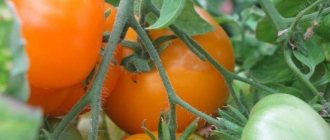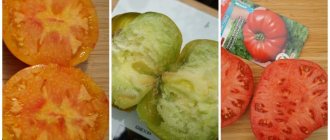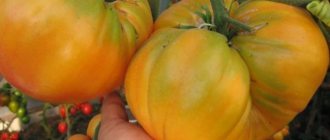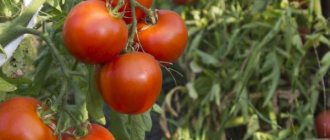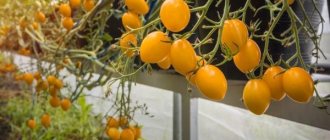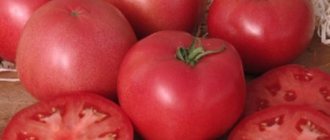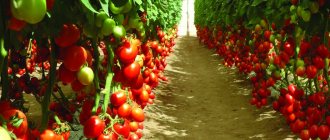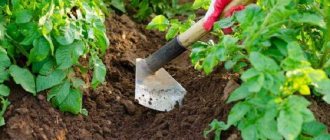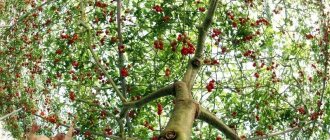For Siberia, breeders have created tomatoes that are grown in open ground conditions. Varieties such as the Velvet Season tomato are successfully cultivated in harsh weather conditions. Even in this climatic zone it is possible not only to grow, but also to obtain high yields.
Breeders are looking for new opportunities to create tomato varieties with decent performance for this type of vegetable. Their work made it possible for vegetable growers to obtain their harvest in areas of risky farming.
The main direction of creating such varieties is aimed at breeding early and low-growing species. Some of the tomatoes they bred are suitable for both the north and the south of the country.
Description and characteristics of the variety
The Velvet Season variety is one of the low-growing determinants. The height of the bush is 50-60 cm. The stems are straight and strong.
Negative weather conditions do not affect the formation of ovaries, fruiting and harvest volume.
The variety is suitable for cultivation in all regions of the country, regardless of climatic conditions.
In northern latitudes it is better to give preference to cultivation in greenhouses or under film; in the southern parts of the country you can safely grow it in open ground. The small and compact size of the bush allows you to cultivate tomatoes in pots.
You can tie the bushes to a support so that the branches do not break off under the weight of ripening fruits. The first harvest is harvested 95-105 days after emergence. Tomatoes are large in size.
The average fruit weight is 200-300 g. Tomatoes are covered with dense and elastic velvety skin. Does not crack due to heavy watering, over-ripening or heat treatment.
Small fruits can be used for canning. Ripe tomatoes have a dark cherry color. The pulp is dense, fleshy, and has a high sugar content. The taste is sweet with pleasant sour notes.
The dense pulp is not watery, so it is not advisable to use for making juices. Tomatoes can be stored after picking from the bush for up to 2 weeks and tolerate transportation well.
The Velvet Season variety is easy to care for. It is enough to follow a simple regime of watering, loosening and mulching to get a stable harvest. Has good disease resistance.
Characteristics and description of the tomato “Velvet Dude”
The “Velvet Dude” tomato variety is distinguished not only by its high taste characteristics, but also by the beauty of the bush. When planting, plants do not take up much space. The height of the bush reaches no more than 1 meter. The compact size allows you to grow tomatoes in small greenhouses and greenhouses.
Tomatoes have an unusual name because their skin has a slight pubescence, like peaches. It gives the tomato a velvety feel. The taste of “Velvet Dude” is endowed with sweetness and slight sour notes. Tomatoes of this variety have a universal purpose. They are ideal for blanks and easily fit into any jar. The elastic peel will protect the tomato from cracking and bursting. Tomatoes are made into salads and used to prepare vegetable stews and other dishes.
Characteristics of the variety
“Velvet Dude” is resistant to temperature changes. It is grown in open ground in the middle and eastern zones of the country; for other regions, preference should be given to greenhouse planting. In terms of ripening, the variety belongs to the mid-early species. The landing period is 65 days.
The fruits grow small in size and neat in shape. The weight of one tomato is 150-200 grams. The peel is colored rich red. When forming a bush, the stepsons are removed, the plant is grown in 1-2 stems. The leaves have a beautiful bluish color.
One bush grows up to 6 kilograms of tomatoes. They ripen in clusters; one cluster contains up to 5 fruits.
Tomatoes were developed recently, but have already received wide distribution and many positive reviews. Gardeners love them for their resistance to disease and insects, as well as their easy cultivation.
Growing
The process of growing tomatoes can be summarized in several points:
Prepare the soil for seedlings in advance. Add 2 parts of peat, ½ part of washed river sand, 1 part of turf, a handful of ash, 1 part of compost into the ground. The land is purchased at the store or brought from the garden.
Planting seeds are placed in a weak aqueous solution of potassium permanganate for 20 minutes. Then place on a paper towel to dry. When the seeds are dry, begin planting. Seeds are placed in the prepared soil and the soil is moistened with a spray bottle. The container with seedlings is covered with a plastic bag and placed on the windowsill. When two or more green leaves appear on the plant, the tomatoes dive
The picking is carried out with extreme caution, trying not to damage the young roots of the plant. After picking, after 2 weeks the first feeding is carried out. Solutions of potassium superphosphate, thiourea, and potassium sulfate are used as fertilizers
They are diluted according to the recommendations for use and watered at the root.
Advantages and disadvantages of the variety
The advantages of the “Velvet Dude” variety include:
- unusual type of tomatoes;
- compact bush size;
- high taste characteristics;
- beautiful velvety leaves and decorative appearance;
- ease of care;
- resistance to low temperatures and the ability to grow outdoors;
- immunity to diseases and pests.
The variety has no complaints or shortcomings.
Diseases and pests
The Velvet Season tomato has strong immunity and resists most diseases and pests. It is enough for the variety to follow simple agricultural techniques. The main thing is to follow the watering regime and not allow the soil to dry out excessively or become waterlogged.
To prevent diseases and pests, bushes can be treated with special preparations or folk remedies can be used.
Crop rotation helps control the development of diseases and repel pests on the site. In order not to provoke infection, you should avoid planting tomatoes in the same place for two years in a row, and also not plant them after peppers, eggplants, and potatoes.
All these crops are susceptible to the same diseases and pests. The best predecessors and neighbors are legumes, cereals, zucchini, cucumbers, cabbage, and greens.
The Velvet Season variety shows good yield. 3.5-4.5 kg of fruits are harvested from 1 bush or up to 10 kg from 1 sq. m with a planting frequency of up to 4 bushes.
Tomato Velvet Season: description of variety, cultivation, photo
Gardeners are interested in how to grow Velvet Season tomatoes. You can also plant tomatoes in harsh climates. To achieve this, Siberian breeders have developed tomato varieties that are resistant to growing in harsh climatic conditions. One of the Siberian varieties is called Velvet Season. This tomato not only grows successfully in cold climates, but also produces good fruit. The creation of resistant varieties of vegetables by breeders has allowed gardeners to grow and obtain high yields. Some of the varieties can be grown in both the north and south of the country.
What is a Velvet Season tomato?
Characteristics and description of the tomato variety Velvet Season:
- The Velvet Season variety, so named because of its velvety peel, is a mid-early ripening variety (fruit ripening time is only 110 days).
- It can be grown in open ground and greenhouses.
- This is a low-growing variety, its bushes grow no higher than 1 m.
- Due to their small size, tomatoes can even be grown on a windowsill.
- The plant has large velvety fruits, round in shape with an elongated bottom, the weight of which can reach 300 g.
- Tomatoes have a rich red color.
- Fleshy fruits with sourness, dense and tender when bitten.
- This variety is characterized by increased sugar content.
- Thanks to the dense peel and lack of wateriness, the berries can be stored for a long time.
This tomato variety is best suited for:
- for fresh use (salads, snacks);
- for pickling;
- for canning.
The dense skin of a tomato does not crack when canned as a whole. This variety can be used to make tomato paste and puree.
How are tomatoes grown?
Let's look at how to sow and plant plants in the ground. Growing tomatoes in cold climates requires preparing the soil in the beds and pre-treating the seeds. The beds in greenhouses are disinfected, loosened, and treated with fertilizers. Work with seeds of this variety begins 60 days before planting in the ground.
Seed treatment consists of the following stages:
- Soak in warm water for 12 to 24 hours.
- Disinfection in a weak solution of potassium permanganate - up to 2 hours.
- Top dressing - keep the seeds in an ash solution (1 tablespoon per 1 liter of water) for up to 12 hours.
All this is done to obtain 100% seed germination. Seedlings are grown at a temperature of + 23…+ 25ºС in shallow boxes. The thickness of the soil layer should be 2-3 cm. The first shoots will appear on days 3-7. Young shoots require lighting, so the boxes are placed on the windowsill.
But you definitely need to make sure there is no draft. On the 10th day, when the sprouts have 2-3 leaves, you need to pick - pinching the main root so that the lateral ones develop. After this procedure, the seedlings are returned to the boxes or planted in separate pots. Place in a warm, well-lit place.
Since morning frosts are a common occurrence in Siberia, seedlings need to be prepared before planting in the ground. A week before the procedure, the seedlings are taken out into the open air for 1 hour. This is how seedlings are hardened. When the soil warms up to a suitable temperature of at least +19ºС, the seedlings are planted in the beds. The seedlings are removed from the box or pots, placed in holes and sprinkled with earth.
The first watering is possible only after 3 days to avoid infection with bacterial rot. After 10 days, you can already install supports for the bushes and tie them with strips of cotton fabric. After the ovary of the first buds, shoots are formed.
To achieve maximum yield, it is necessary to feed the plants with nutrients. The first feeding is done 7-10 days after transplanting the seedlings into the ground. For this, a solution of cow dung is used.
The second feeding is done a week after the first with a solution of chicken manure (1 tbsp per 10 liters of water). It is better to alternate feeding every 7-10 days. Despite the cold climate, having mastered all the nuances of cultivation, you can get good harvests.
Siberian tomato varieties are very popular; the Velvet season has become the most popular for growing in regions with cold climates.
Advantages and disadvantages of the Velvet Season variety
The variety has a number of positive qualities:
- tolerance to adverse weather conditions;
- resistance to drought and heat;
- high rates of seed germination;
- good taste;
- active, friendly fruiting;
- immunity to most diseases.
Among the shortcomings of the variety, no significant ones have been identified to warrant attention.
Planting tomatoes
Despite their resistance to cool weather, it is recommended to grow Velvet Season tomatoes through seedlings. Sowing of seeds begins in March 55-60 days before the expected planting date.
Transplantation to a permanent place of growth is carried out in May, when night frosts stop and the earth warms up.
Growing seedlings
To accelerate the rate of growth and fruiting, it is recommended that tomato seeds be prepared and treated with disinfecting solutions and growth stimulants before sowing. For disinfection, special preparations or a weak solution of potassium permanganate are used.
Tomatoes need a lot of sunlight. Window sills facing the sunny side are chosen as a permanent place for growing seedlings. The duration of daylight should be at least 10 hours.
If there is a shortage, additional light sources are installed. Any lamps will do, but fluorescent or phytolamps show the greatest efficiency.
After 10-14 days, when 2-3 true leaves are formed, the seedlings are picked. Transplanting into a larger container and pinching the main root provokes the beginning of the growth of lateral branches. The root system of the plant becomes strong and strong.
A week before transferring the seedlings to a permanent place of growth, it is recommended to begin hardening off the tomatoes. They are taken outside or into a cool room. Recommended air temperature is +14 degrees.
Transplanting seedlings into open ground
Transplantation occurs in prepared soil. It is dug up in advance, humus and wood ash are added. Dig shallow holes and add compost to the bottom. Then water it with water. The seedlings are fixed in the center, sprinkled with earth and compacted a little.
Description of the tomato variety Velvet Season, its characteristics and yield
For Siberia, breeders have created tomatoes that are grown in open ground conditions. Varieties such as the Velvet Season tomato are successfully cultivated in harsh weather conditions. Even in this climatic zone it is possible not only to grow, but also to obtain high yields.
Breeders are looking for new opportunities to create tomato varieties with decent performance for this type of vegetable. Their work made it possible for vegetable growers to obtain their harvest in areas of risky farming.
The main direction of creating such varieties is aimed at breeding early and low-growing species. Some of the tomatoes they bred are suitable for both the north and the south of the country.
Descriptive characteristics of the variety
Velvet Season tomatoes are mid-early tomatoes. It is distinguished by low bushes (determinant variety) and is suitable for growing both in open beds and under film covers. The height of mature bushes is approximately 50–70 cm.
The characteristics and description of the variety include information about the fruits. They are fleshy and rich red in color. Their shape is round with a slightly elongated bottom. One tomato can weigh 300g, but most weigh 100g.
The pulp has increased sugar content, and when you bite you feel its density and tenderness. Thanks to their elastic structure, they can be stored for a long time. When grown, these plants are resistant to peel cracking.
This variety of tomatoes is intended:
- for fresh use,
- for salting.
Canned well whole. The thick skin is resistant to cracking after being poured with hot water during preservation.
When squeezing the juice out of these tomatoes, a puree-like mass is obtained, so Velvet Season tomatoes are practically not used for this purpose.
Questions about planting tomatoes
Weather conditions have minimal impact on obtaining an excellent harvest. As a rule, velvet tomatoes have a stable yield. If agrotechnological requirements are observed, as well as with regular feeding, up to 5–7 kg of vegetables of this variety can be obtained from 1 m2.
Planting seeds of this variety begins 50–60 days before the optimum temperature occurs, allowing seedlings to be planted in open ground. Seed cultivation is carried out indoors with a temperature of about 23–25 ⁰С. Tomatoes are planted in open beds after the soil has warmed to 15 degrees.
To ensure quick and friendly seedlings, you can pre-treat the seed material with ready-made products to stimulate their growth.
The variety is resistant to typical diseases that can affect these vegetables. Early ripening of fruits protects them from late blight.
Features of care
The first watering is carried out no earlier than 3 days after transplantation. Plants need to be given time to get used to and take root. After 7-10 days, you can install supports to secure the bushes.
Afterwards, watering is carried out as the top layer of soil dries with warm water under the root. The best time to water is early morning or late evening. It is not recommended to use a sprayer when watering so that moisture does not get on the leaves and stem.
It is necessary to regularly loosen and mulch the soil for better oxygen supply and moisture retention.
The development of the root system of tomatoes during the Velvet Season is facilitated by hilling the bushes. During the season the procedure is carried out 1-2 times.
Velvet Season tomatoes are an unpretentious variety that is suitable even for growing in Siberia. The process is practically no different from the classical requirements for culture, with the exception of the need for tying up bushes and hilling.
Features of cultivation and storage
Seedlings begin to grow from the beginning of March until May. Seeds are sown in light fertile soil, enriched with ash and compost, with the addition of peat and sand. To speed up germination, use “Agat 25” or “Kornevin”.
Seedling care includes:
- until germination, keeping at 22-24 °C;
- hardening at 14-15 °C;
- irrigation with warm water;
- diving with 3 true leaves.
The shelf life of ripe tomatoes is up to 2 weeks.
